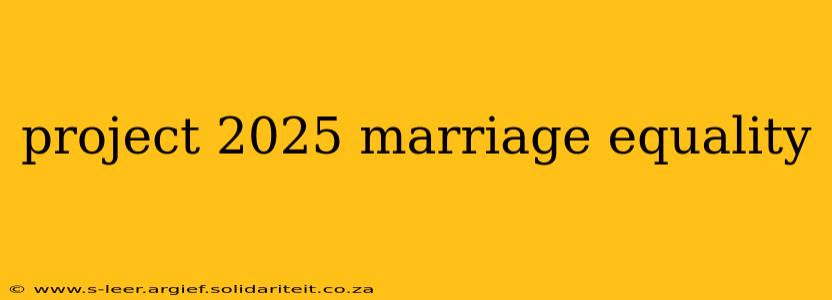The year 2025 marks a significant point in the ongoing journey towards global marriage equality. While significant strides have been made, challenges remain, and the fight for full LGBTQ+ rights continues to evolve. This article explores the current landscape of marriage equality, focusing on the progress made, persistent obstacles, and future prospects for Project 2025 (a hypothetical framework for continued advocacy). We will delve into key questions surrounding the issue, providing a comprehensive overview of this important social and political movement.
What is the current state of marriage equality globally in 2024?
As of late 2024, a significant portion of the world has legalized same-sex marriage. However, this progress is far from universal. Countries in North America, Western Europe, Australia, New Zealand, and parts of South America have largely embraced marriage equality. Conversely, many countries in Africa, Asia, and the Middle East maintain laws criminalizing same-sex relationships, let alone marriage. Even in countries where same-sex marriage is legal, LGBTQ+ individuals often face discrimination and societal prejudice. The legal landscape is complex, with varying levels of recognition and protection afforded to same-sex couples even within countries where marriage equality exists. The uneven distribution highlights the ongoing need for advocacy and legislative change.
What are the main obstacles to achieving global marriage equality?
Several key obstacles hinder the global movement for marriage equality. These include:
- Religious and Cultural Objections: Deeply rooted religious and cultural beliefs often form the basis of opposition to same-sex marriage. These objections can be powerful, influencing political discourse and shaping public opinion.
- Political Opposition: Conservative political forces often actively oppose marriage equality legislation, leveraging these religious and cultural arguments for political gain. This opposition can manifest as legislative gridlock, judicial challenges, and public campaigns against LGBTQ+ rights.
- Lack of Awareness and Education: Misinformation and stigma surrounding LGBTQ+ issues contribute to societal prejudice and resistance to change. Increased education and awareness campaigns are crucial to shifting public opinion and fostering acceptance.
- International Legal Frameworks: The absence of strong international legal frameworks protecting LGBTQ+ rights leaves many individuals vulnerable to discrimination and persecution. This necessitates international collaboration and advocacy for global human rights standards.
What legal protections are in place for same-sex couples in countries where marriage is legal?
While marriage equality grants legal recognition to same-sex couples, the specific protections afforded can vary significantly. In many jurisdictions, this includes the right to adopt children, access to spousal benefits (health insurance, inheritance, etc.), and equal treatment under the law. However, even in countries where same-sex marriage is legal, discrimination can still occur in areas like housing, employment, and healthcare. The extent of legal protection depends on the specific legislation implemented in each country and the strength of enforcement mechanisms.
What are the biggest challenges for LGBTQ+ individuals in countries where same-sex marriage is not legal?
In countries where same-sex marriage is illegal, LGBTQ+ individuals face a range of challenges, including:
- Criminalization: In some countries, same-sex relationships are criminalized, leading to imprisonment, fines, and other forms of persecution.
- Discrimination: LGBTQ+ individuals frequently experience discrimination in employment, housing, healthcare, and other aspects of daily life.
- Social Stigma: Societal stigma and prejudice create a hostile environment, leading to isolation, harassment, and violence.
- Lack of Legal Protection: The absence of legal protections leaves LGBTQ+ individuals vulnerable to abuse and exploitation.
What is the role of international organizations in promoting marriage equality?
International organizations, such as the United Nations and various human rights NGOs, play a critical role in promoting marriage equality through advocacy, research, and the development of international standards. They raise awareness, document human rights abuses, and push for legislative reforms in countries where LGBTQ+ rights are violated. Their work is crucial in holding nations accountable to international human rights obligations and promoting a more inclusive global society.
What can individuals do to support marriage equality efforts?
Individuals can support marriage equality efforts through various means, including:
- Advocacy: Contacting elected officials to express support for marriage equality legislation and lobbying for policy changes.
- Education: Educating oneself and others about LGBTQ+ issues and challenging homophobic and transphobic attitudes.
- Donations: Supporting LGBTQ+ rights organizations through donations.
- Allyship: Actively supporting LGBTQ+ individuals and communities.
Project 2025, while hypothetical, highlights the need for continued, sustained effort in the fight for global marriage equality. The journey towards full inclusion and equality is far from over, but through dedicated advocacy, education, and international collaboration, a more just and equitable future for LGBTQ+ individuals is possible. The focus must remain on dismantling discriminatory laws, challenging societal prejudice, and fostering a world where love and equality prevail.
